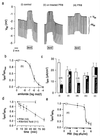Influenza virus inhibits amiloride-sensitive Na+ channels in respiratory epithelia
- PMID: 10920189
- PMCID: PMC27875
- DOI: 10.1073/pnas.160041997
Influenza virus inhibits amiloride-sensitive Na+ channels in respiratory epithelia
Abstract
Many pathogens causing diarrhea do so by modulating ion transport in the gut. Respiratory pathogens are similarly associated with disturbances of fluid balance in the respiratory tract, although it is not known whether they too act by altering epithelial ion transport. Here we show that influenza virus A/PR/8/34 inhibits the amiloride-sensitive Na(+) current across mouse tracheal epithelium with a half-time of about 60 min. We further show that the inhibitory effect of the influenza virus is caused by the binding of viral hemagglutinin to a cell-surface receptor, which then activates phospholipase C and protein kinase C. Given the importance of epithelial Na(+) channels in controlling the amount of fluid in the respiratory tract, we suggest that down-regulation of Na(+) channels induced by influenza virus may play a role in the fluid transport abnormalities that are associated with influenza infections.
Figures




Comment in
-
Amiloride-sensitive sodium channels contribute to the woes of the flu.Proc Natl Acad Sci U S A. 2000 Aug 29;97(18):9827-9. doi: 10.1073/pnas.97.18.9827. Proc Natl Acad Sci U S A. 2000. PMID: 10963654 Free PMC article. Review. No abstract available.
Similar articles
-
Amiloride-sensitive sodium channels contribute to the woes of the flu.Proc Natl Acad Sci U S A. 2000 Aug 29;97(18):9827-9. doi: 10.1073/pnas.97.18.9827. Proc Natl Acad Sci U S A. 2000. PMID: 10963654 Free PMC article. Review. No abstract available.
-
Effects of purinergic stimulation, CFTR and osmotic stress on amiloride-sensitive Na+ transport in epithelia and Xenopus oocytes.J Membr Biol. 2003 Mar 15;192(2):101-10. doi: 10.1007/s00232-002-1067-8. J Membr Biol. 2003. PMID: 12682798
-
Inhibition of airway Na+ transport by respiratory syncytial virus.J Virol. 2007 Apr;81(8):3714-20. doi: 10.1128/JVI.02621-06. Epub 2007 Feb 7. J Virol. 2007. PMID: 17287265 Free PMC article.
-
Epidermal growth factor inhibits amiloride-sensitive sodium absorption in renal collecting duct cells.Am J Physiol Renal Physiol. 2003 Jan;284(1):F57-64. doi: 10.1152/ajprenal.00028.2002. Epub 2002 Aug 27. Am J Physiol Renal Physiol. 2003. PMID: 12388407
-
Extracellular hypotonicity increases Na,K-ATPase cell surface expression via enhanced Na+ influx in cultured renal collecting duct cells.J Am Soc Nephrol. 2004 Oct;15(10):2537-47. doi: 10.1097/01.ASN.0000139931.81844.10. J Am Soc Nephrol. 2004. PMID: 15466258 Review.
Cited by
-
Reduced activity of the epithelial sodium channel in malaria-induced pulmonary oedema in mice.Int J Parasitol. 2011 Jan;41(1):81-8. doi: 10.1016/j.ijpara.2010.07.013. Epub 2010 Sep 17. Int J Parasitol. 2011. PMID: 20816846 Free PMC article.
-
Influenza A virus inhibits alveolar fluid clearance in BALB/c mice.Am J Respir Crit Care Med. 2008 Nov 1;178(9):969-76. doi: 10.1164/rccm.200803-455OC. Epub 2008 Aug 8. Am J Respir Crit Care Med. 2008. PMID: 18689466 Free PMC article.
-
The activity of the epithelial sodium channels is regulated by caveolin-1 via a Nedd4-2-dependent mechanism.J Biol Chem. 2009 May 8;284(19):12663-9. doi: 10.1074/jbc.M809737200. Epub 2009 Mar 20. J Biol Chem. 2009. PMID: 19304660 Free PMC article.
-
Amiloride-sensitive sodium channels contribute to the woes of the flu.Proc Natl Acad Sci U S A. 2000 Aug 29;97(18):9827-9. doi: 10.1073/pnas.97.18.9827. Proc Natl Acad Sci U S A. 2000. PMID: 10963654 Free PMC article. Review. No abstract available.
-
Avian influenza: the next pandemic?Dis Mon. 2007 Jul;53(7):348-87. doi: 10.1016/j.disamonth.2007.05.006. Dis Mon. 2007. PMID: 17689670 Free PMC article. Review. No abstract available.
References
-
- Matalon S, O'Brodovich H. Annu Rev Physiol. 1999;61:627–661. - PubMed
-
- Kerem E, Bistritzer T, Hanukoglu A, Hofmann T, Zhou Z, Bennett W, MacLaughlin E, Barker P, Nash M, Quittell L, et al. N Engl J Med. 1999;341:156–162. - PubMed
-
- Hummler E, Barker P, Gatzy J, Beermann F, Verdumo C, Schmidt A, Boucher R, Rossier B C. Nat Genet. 1996;12:325–328. - PubMed
Publication types
MeSH terms
Substances
LinkOut - more resources
Full Text Sources
Other Literature Sources
Research Materials

